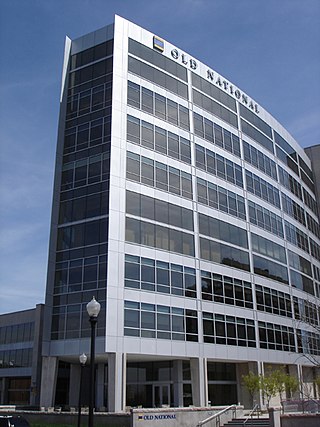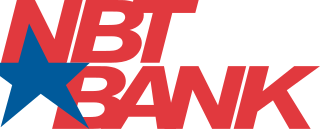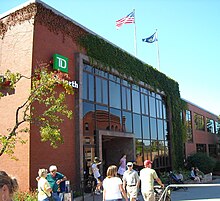
Toronto-Dominion Bank, doing business as TD Bank Group, is a Canadian multinational banking and financial services corporation headquartered in Toronto, Ontario. The bank was created on February 1, 1955, through the merger of the Bank of Toronto and The Dominion Bank, which were founded in 1855 and 1869; respectively. It is one of two Big Five banks of Canada founded in Toronto, the other being the Canadian Imperial Bank of Commerce. The TD Bank SWIFT code is TDOMCATTTOR and the TD institution number is 004.

U.S. Bancorp is an American bank holding company based in Minneapolis, Minnesota, and incorporated in Delaware. It is the parent company of U.S. Bank National Association, and is the fifth largest banking institution in the United States. The company provides banking, investment, mortgage, trust, and payment services products to individuals, businesses, governmental entities, and other financial institutions. As of 2019, it had 3,106 branches and 4,842 automated teller machines, primarily in the Western and Midwestern United States. In 2023 it ranked 149th on the Fortune 500, and it is considered a systemically important bank by the Financial Stability Board. The company also owns Elavon, a processor of credit card transactions for merchants, and Elan Financial Services, a credit card issuer that issues credit card products on behalf of small credit unions and banks across the U.S.

Citizens Financial Group, Inc. is an American bank headquartered in Providence, Rhode Island, which operates in the states of Connecticut, Delaware, Florida, Maryland, Massachusetts, Michigan, New Hampshire, New Jersey, New York, Ohio, Pennsylvania, Rhode Island, Vermont, and Virginia, as well as Washington, DC.
TD Bank, N.A. is an American national bank and the United States subsidiary of the multinational TD Bank Group. It operates primarily across the East Coast, in fifteen U.S. states and Washington, D.C. TD Bank is the seventh-largest U.S. bank by deposits and the 11th largest bank in the United States by total assets, resulting from a series of several mergers and acquisitions. TD Bank, N.A. is headquartered in Cherry Hill, New Jersey, a proximal suburb eight miles outside Philadelphia. TD Bank is a federally chartered bank, thus its trading name bears "N.A." letters.

M&T Bank Corporation is an American bank holding company headquartered in Buffalo, New York. It operates 1,000+ branches in 12 states across the Eastern United States, from Maine to Northern Virginia. Until May 1998, the bank's holding company was named First Empire State Corporation.

National City Corporation was a regional bank holding company based in Cleveland, Ohio, founded in 1845; it was once one of the ten largest banks in America in terms of deposits, mortgages and home equity lines of credit. Subsidiary National City Mortgage is credited for doing the first mortgage in America. The company operated through an extensive banking network primarily in Ohio, Illinois, Indiana, Kentucky, Michigan, Missouri, Pennsylvania, Florida, and Wisconsin, and also served customers in selected markets nationally. Its core businesses included commercial and retail banking, mortgage financing and servicing, consumer finance, and asset management. The bank reached out to customers primarily through mass advertising and offered comprehensive banking services online. In its last years, the company was commonly known in the media by the abbreviated NatCity, with its investment banking arm even bearing the official name NatCity Investments.

The National Bank of Detroit (NBD), later renamed NBD Bank, was a bank that operated mostly in the Midwestern United States. Following its merger with First National Bank of Chicago, the bank was ultimately acquired and merged into Bank One, at which point the NBD name was discontinued. Today, what was once NBD is owned by JPMorgan Chase & Co.

KeyBank, the primary subsidiary of KeyCorp, is an American regional bank headquartered in Cleveland, Ohio. Key ranked 449th on the 2022 Fortune 500 list based on its 2021 revenue. It is 25th on the list of largest banks in the United States.

Old National Bank is an American regional bank with nearly 200 retail branches operated by Old National Bancorp and based in Chicago and Evansville, Indiana. With assets at $23.0 billion and 162 banking centers, Old National Bancorp is the largest financial services bank holding company headquartered in Indiana and one of the top 100 banking companies in the U.S. Its primary banking footprint is in Illinois, Indiana, Kentucky, Michigan, Minnesota, and Wisconsin.

NBT Bank, N.A. is an American financial institution that operates through a network of 140 banking locations in New York, Pennsylvania, Vermont, Massachusetts, New Hampshire, Maine and Connecticut. NBT Bank and its parent company, NBT Bancorp Inc., are headquartered in Norwich, New York, United States. NBT Bancorp is traded on the Nasdaq Global Select Market under the symbol NBTB.

People's United Financial, Inc., was an American bank holding company that owned People's United Bank. The bank operated 403 branches in Connecticut, southeastern New York State, Massachusetts, Vermont, Maine, and New Hampshire. It was the second-largest full-service bank in New England, one of the largest in the northeast, and the 46th-largest in the United States.

Commerce Bank & Trust Company is a financial institution based in Worcester, Massachusetts with 16 branches located throughout central and eastern Massachusetts. Commerce Bank & Trust was founded in 1955 and is now a full-service commercial bank with branch offices in Worcester, Holden, Leominster, Marlborough, Milford, Shrewsbury, Webster, West Boylston, Westborough, and, through its recent acquisition of Mercantile Bank & Trust Company, Boston.

Commerce Bancorp was a Cherry Hill, New Jersey–based bank created in 1973. In 2007, it was purchased by Toronto-Dominion Bank, which merged Commerce with TD Banknorth to form TD Bank, N.A.; all of its banks and branches were given the TD Bank logo.
Rockland Trust is a commercial bank based in Rockland, Massachusetts that serves Southeastern Massachusetts, Coastal Massachusetts, Cape Cod, and Boston's MetroWest. Established in 1907 as Rockland Trust Company. A wholly owned subsidiary of Independent Bank Corp., by October 2016, Rockland Trust had $7.5 billion in assets and employed around 1,000 people. By April 2022, Rockland Trust had $20 billion in assets and employed around 1,100 people.

The Dime Savings Bank of New York, originally the Dime Savings Bank of Brooklyn, was a bank headquartered in Brooklyn, New York City. It operated from 1859 to 2002.

First Bank System was a Minneapolis, Minnesota-based regional bank holding company that operated from 1864 to 1997. What was once First Bank forms the core of today's U.S. Bancorp; First Bank merged with the old U.S. Bancorp in 1997 and took the U.S. Bancorp name.
Pacific Premier Bancorp, Inc. is a registered holding company under the Bank Holding Company Act of 1956 headquartered in Irvine, California, US. Its principal business focuses on Pacific Premier Bank, which offers a range of financial services to individuals, businesses, and professionals. The bank operates numerous branches in California, Arizona, Nevada, and Washington. Pacific Premier Bank offers commercial escrow services and facilitates 1031 Exchange transactions through its Commerce Escrow division.
Bharat Masrani is an Indian-Canadian financial executive who is currently the Group President and Chief Executive Officer of the Toronto-Dominion Bank. Masrani was appointed to this role on November 1, 2014.
INB Financial Corporation was an Indianapolis-based statewide bank holding company that was the largest Indiana-based financial institution at the time it was acquired by Michigan-based NBD Bancorp in 1992. Its primary subsidiary was the Indianapolis-based INB National Bank, formerly the Indiana National Bank, which can trace its origins to the founding of the Second State Bank of Indiana in 1834.

Star Banc Corporation was a Cincinnati, Ohio-based regional bank holding company that acquired Firstar in 1998 and took the Firstar name; the merged bank acquired U.S. Bancorp in 2001 and took the U.S. Bancorp name. The company can trace its origins back to 1863 when it was first founded as the First National Bank of Cincinnati.















